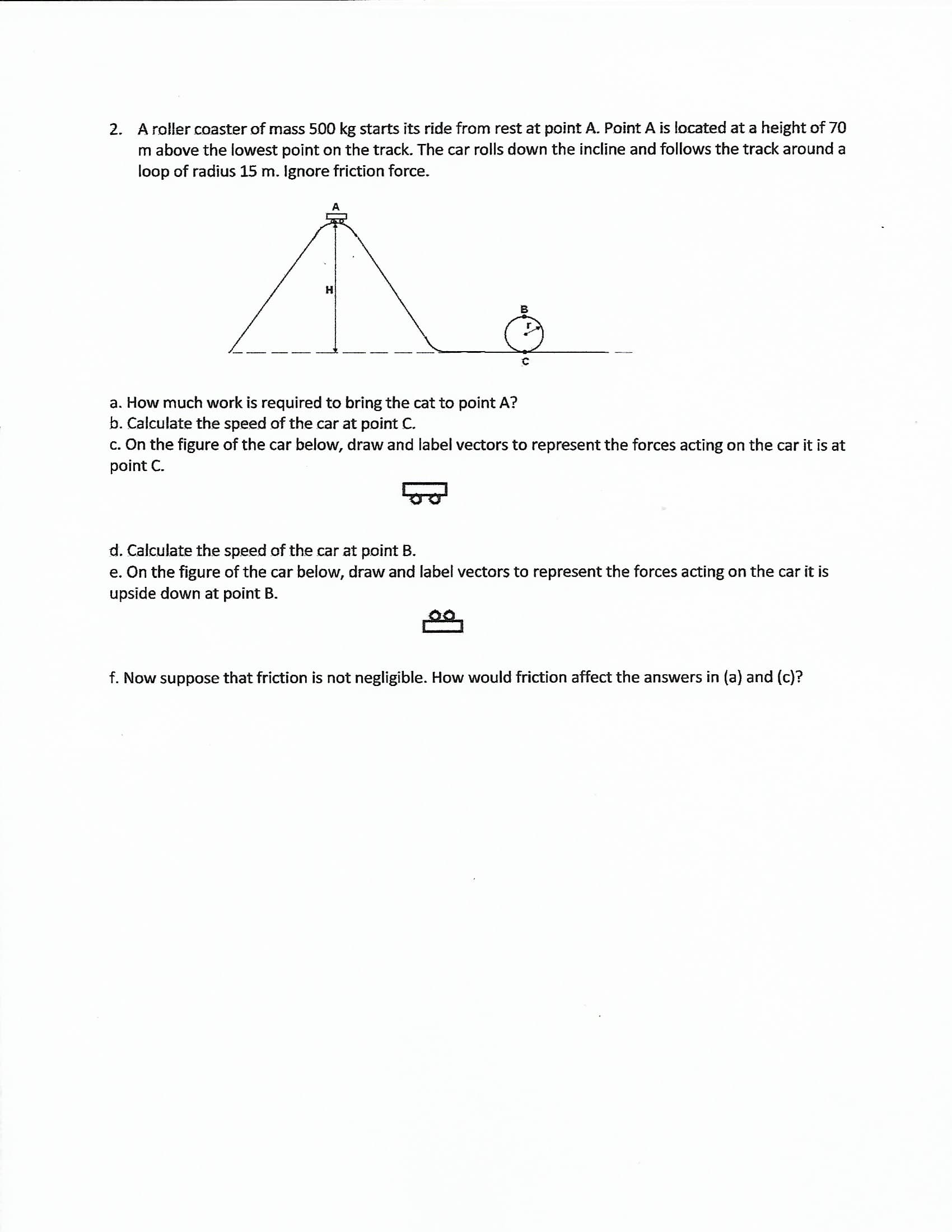2. A roller coaster of mass 500 kg starts its ride from rest at point A. Point A is located at a height of 70 m above the lowest point on the track. The car rolls down the incline and follows the track around a loop of radius 15 m. Ignore friction force. a. How much work is required to bring the cat to point A? b. Calculate the speed of the car at point C. c. On the figure of the car below, draw and label vectors to represent the forces acting on the car it is at point C. d. Calculate the speed of the car at point B. e. On the figure of the car below, draw and label vectors to represent the forces acting on the car it is upside down at point B. f. Now suppose that friction is not negligible. How would friction affect the answers in (a) and (c)?
2. A roller coaster of mass 500 kg starts its ride from rest at point A. Point A is located at a height of 70 m above the lowest point on the track. The car rolls down the incline and follows the track around a loop of radius 15 m. Ignore friction force. a. How much work is required to bring the cat to point A? b. Calculate the speed of the car at point C. c. On the figure of the car below, draw and label vectors to represent the forces acting on the car it is at point C. d. Calculate the speed of the car at point B. e. On the figure of the car below, draw and label vectors to represent the forces acting on the car it is upside down at point B. f. Now suppose that friction is not negligible. How would friction affect the answers in (a) and (c)?
Physics for Scientists and Engineers with Modern Physics
10th Edition
ISBN:9781337553292
Author:Raymond A. Serway, John W. Jewett
Publisher:Raymond A. Serway, John W. Jewett
Chapter7: Energy Of A System
Section: Chapter Questions
Problem 30P: A 1 000-kg roller coaster car is initially at the top of a rise, at point . It then moves 135 ft, at...
Related questions
Question
100%

Transcribed Image Text:2. A roller coaster of mass 500 kg starts its ride from rest at point A. Point A is located at a height of 70
m above the lowest point on the track. The car rolls down the incline and follows the track around a
loop of radius 15 m. Ignore friction force.
a. How much work is required to bring the cat to point A?
b. Calculate the speed of the car at point C.
c. On the figure of the car below, draw and label vectors to represent the forces acting on the car it is at
point C.
d. Calculate the speed of the car at point B.
e. On the figure of the car below, draw and label vectors to represent the forces acting on the car it is
upside down at point B.
f. Now suppose that friction is not negligible. How would friction affect the answers in (a) and (c)?
Expert Solution
This question has been solved!
Explore an expertly crafted, step-by-step solution for a thorough understanding of key concepts.
This is a popular solution!
Trending now
This is a popular solution!
Step by step
Solved in 6 steps with 9 images

Recommended textbooks for you

Physics for Scientists and Engineers with Modern …
Physics
ISBN:
9781337553292
Author:
Raymond A. Serway, John W. Jewett
Publisher:
Cengage Learning

Physics for Scientists and Engineers
Physics
ISBN:
9781337553278
Author:
Raymond A. Serway, John W. Jewett
Publisher:
Cengage Learning

Principles of Physics: A Calculus-Based Text
Physics
ISBN:
9781133104261
Author:
Raymond A. Serway, John W. Jewett
Publisher:
Cengage Learning

Physics for Scientists and Engineers with Modern …
Physics
ISBN:
9781337553292
Author:
Raymond A. Serway, John W. Jewett
Publisher:
Cengage Learning

Physics for Scientists and Engineers
Physics
ISBN:
9781337553278
Author:
Raymond A. Serway, John W. Jewett
Publisher:
Cengage Learning

Principles of Physics: A Calculus-Based Text
Physics
ISBN:
9781133104261
Author:
Raymond A. Serway, John W. Jewett
Publisher:
Cengage Learning

Classical Dynamics of Particles and Systems
Physics
ISBN:
9780534408961
Author:
Stephen T. Thornton, Jerry B. Marion
Publisher:
Cengage Learning

College Physics
Physics
ISBN:
9781305952300
Author:
Raymond A. Serway, Chris Vuille
Publisher:
Cengage Learning

College Physics
Physics
ISBN:
9781285737027
Author:
Raymond A. Serway, Chris Vuille
Publisher:
Cengage Learning